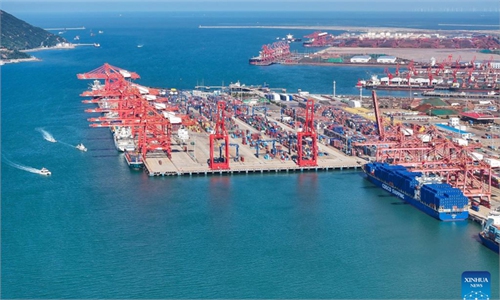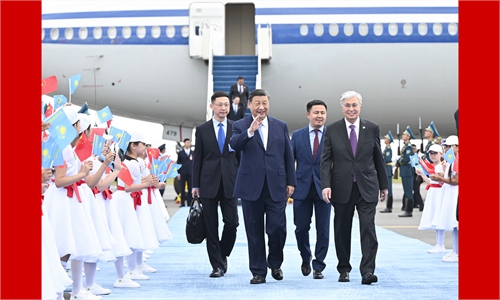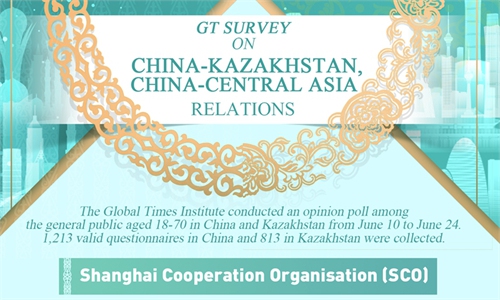China-Central Asia closer ties set an example for economic partnerships: Kazakh scholar

A view of Astana, the capital city of Kazakhstan Photo: VCG
Editor's Note:
Amid the 24th Meeting of the Council of Heads of State of the Shanghai Cooperation Organisation (SCO) in Astana, Kazakhstan, the Global Times reporters Li Xuanmin and Xing Xiaojing (GT)interviewed Aliya Mussabekova (Mussabekova), chief expert at the Asian Studies Department at Kazakhstan Institute for Strategic Studies under the President of the Republic of Kazakhstan, and Maryam Agharabi (Agharabi), research coordinator at China & Central Asia Studies Center (CCASC) in Kazakhstan.
The two Kazakh scholars discussed the permanent comprehensive strategic partnership between China and Kazakhstan, which they said is built on the deep-rooted shared vision between the two countries. Also, the SCO, which China and Kazakhstan are founding members, has made significant and consistent contributions to shaping the global agenda of equality and cooperation, they said, adding that the SCO summit in Astana will enhance cooperation on green transition, digital transformation, rare earth exploration as well as the development of the Middle Corridor.

Maryam Agharabi Photo: Courtesy of Maryam Agharabi
GT: The 24th meeting of the Council of Heads of State of the Shanghai Cooperation Organisation (SCO) is held in Astana, Kazakhstan. What are your expectations of the meeting, and how will the meeting contribute to regional security and stability?
Agharabi: The upcoming SCO summit in Astana is a major event, not just regionally, but also globally. The SCO is one of the most important intergovernmental organizations, and the upcoming meetings between heads of state and their delegates are expected to cover many critical discussions and decisions that will affect the future of all forms of cooperation in the Central Asia region.
As usual, key themes including security, trade, investment, transport, and scientific and cultural ties will be on the table. But for this year, I think special attention will be given to the development of the Middle Corridor, or the Trans-Caspian International Transport Route, which could geographically be the shortest route between Western China and Europe and an important passage for Eurasian trade and transit. In addition, given the growing importance of rare earth materials which are critical to the future of industries and abundant in Central Asia, the mining sector is another area to watch for development.
Personally, I hope to hear more about enhanced cooperation and concerted efforts on two specific fronts - one is on green transition, climate change mitigation in Central Asia, and the other is digital transformation. These are incredibly important areas for Central Asian economies, including Kazakhstan, and coincidentally, they are also areas where China has a wealth of expertise and experience to share.
GT: In 2019, China and Kazakhstan decided to develop a permanent comprehensive strategic partnership. How do you interpret the connotation of the permanent comprehensive strategic partnership between the two countries?
Agharabi: To me, the term "permanent comprehensive strategic partnership" sums up key concepts that should frame our mindset about the future of relations between China and Kazakhstan. First of all, the permanence of the relationship acknowledges the fact that as neighbors, the two sides live with each other constructively and respectfully. Secondly, this partnership has unique strategic value. Imagine Kazakhstan's role as a gateway westward for China's trade, or how partnering with China is crucial for Kazakhstan's security or its access to larger markets and open seas. Finally, understanding the relationship as a "comprehensive" one points to the broad range of areas in which the two countries cooperate, from trade and investment to security and cultural exchange.
Also, in areas such as regional stability, advancing economic cooperation, and aiming for sustainable development, there is a deep-rooted shared vision between China and Kazakhstan.
GT: From your perspective, how would cooperation between China and Kazakhstan set an example for Central Asia, as well as for the world?
Agharabi: The Central Asia region holds significant economic potential, rich in natural resources, a thriving population, and many untapped potentials. In this regional context, Kazakhstan provides the necessary economic, regulatory, and geopolitical stability that is needed to enter the region. Many international corporations come to Kazakhstan to set up branches, manufacturing lines, or representative offices, not just to enter Kazakhstan's market, but also with a regional outreach. At the same time, we are witnessing increasingly closer ties between the leaderships of the countries within Central Asia.
All of these factors facilitate a "regional" mode of planning for entities looking to enter Central Asia. This is the context in which we can understand the need for high-level formats of interaction, such as the China-Central Asia Summit, in Xi'an, Northwest China's Shaanxi Province, last year. The participants during the summit reaffirm their desire to jointly work together for an even closer China-Central Asia community with a shared future, which I think revolves around acknowledging the need for closer ties and deeper cooperation through various initiatives and mechanisms, while importantly, upholding international law and the sovereign equality of states. This frame of thought and vision sets a good example for regional cooperation anywhere in the world.
GT: The year 2024 is designated as the China-Kazakhstan Tourism Year. The mutual visa exemption policy starting in November 2023 has promoted business exchanges, trade, investment, and tourism between the two countries. How do you view the personnel exchanges and cultural interactions between China and Kazakhstan?
Agharabi: The visa policy is an important part of the people-to-people aspect of bilateral ties, which allows the citizens of the two countries to interact directly with each other. This kind of exchange is a necessary step in deepening ties between the two countries, and in this case, it is certainly welcomed by citizens on both sides, as evidenced by the growing number of visits.
The political resolve on both sides has been bringing the two countries closer together, and we can see that the business communities have embraced this direction. China is Kazakhstan's top trading partner and a major source of investment. Also, we now witness a growing interest in learning the Chinese language, choosing China as a higher education destination, or exploring Chinese culture among Kazakh young generation. I think this is a very natural stage of progression in relations between Kazakhstan and China.
GT: In 2013, China proposed the idea of building an "economic belt along the Silk Road" in Kazakhstan, which, combined with the proposal of the 21st Century Maritime Silk Road, forms the Belt and Road Initiative (BRI). In the 11th year of BRI development, what new highlights have emerged in the cooperation between the two countries?
Agharabi: Kazakhstan is Central Asia's largest country by size and the largest economy in the region. Many key BRI projects, particularly infrastructure connectivity projects, have been launched in Kazakhstan, and they have significantly contributed to economic integration and development in the region. In terms of new development in the second decade, I think we are seeing a steady shift from urgent projects, such as the development of rail and road hard infrastructure, to soft infrastructure and more diversified areas of cooperation.
GT: China, Kyrgyzstan and Uzbekistan have signed an intergovernmental agreement to build the China-Kyrgyzstan-Uzbekistan railway project. What are your expectations for the railway, and how would it improve the exchange with Central Asia?
Agharabi: This transnational railway project is an important, long-awaited, and highly anticipated development from various perspectives. Broadly speaking, it contributes to the cooperative approach within the region, meaning that it not only helps diversify trade and transit by adding an extra route connecting Central Asian countries in both east-west and north-south directions, but also demonstrates a commitment to the development of the region as a whole in the spirit of regional economic cooperation.
It is important to understand that sustainable development should be viewed as a collective endeavor shared among neighbors, so, although for example Kazakhstan is not a direct party to this project, this is certainly welcomed by Kazakhstan. We need to remember that the future is shared among neighbors, in the same spirit of "common destiny." In that sense, I think the project launch is a positive development not only for China, Kyrgyzstan and Uzbekistan, which will see direct and immediate economic benefits, but also for the rest of the Central Asian countries and beyond.




